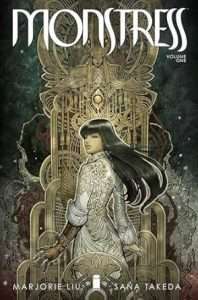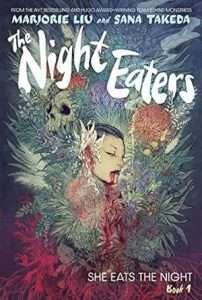INTERVIEW: Marjorie Liu
Last Updated on January 23, 2025
Marjorie Liu is a New York Times best-selling author and comic book writer best known for her grimdark fantasy comic series, Monstress, which is set in a darkly beautiful alternate version of Asia circa early 1900s. The war-torn world of Monstress is matriarchal and infused with elements of steampunk and psychic magic. Like the best works of grimdark, Marjorie Liu’s story is rich and dark, balancing external conflict with an equally devastating internal turmoil. Liu won the 2017 Hugo Award for her first Monstress collection, and in 2018 she became the first woman to win the Eisner Award for Best Writer. We recently had the pleasure of interviewing Marjorie Liu regarding her approach to storytelling, her influences, and her projects beyond Monstress.
 [GdM] Who were some of your early influences as a writer? Were there specific authors, comics, or storytellers who shaped your creative voice?
[GdM] Who were some of your early influences as a writer? Were there specific authors, comics, or storytellers who shaped your creative voice?
[ML] From a young age I was such a voracious reader that now, after all these years, everything has become blended—but there were certainly some very pivotal books and authors—and teachers—who made me rethink language and narrative, and what’s possible as a writer. Before them, I thought I knew what a book could be—after them, I realized I didn’t know anything at all. Those authors were Jorge Luis Borges and Isabelle Allende. My English teacher in high school assigned us Borges’ Labyrinths and Allende’s The Stories of Eva Luna—and it was the first time I felt as though I was reading poetry in prose form. Every sentence meant something, nothing was wasted, each word felt chosen with intention—but more importantly, being immersed in their stories made me think, learn, expand—as if I could grow beyond my own skin. It’s hard to describe, in a way—and it’s not as if Borges and Allende made me decide then and there that I would become a novelist—but I suddenly had the smallest glimpse of a much larger narrative world, and that made me hungry to learn more.
My other important influence was Professor Peter Fritzell, whose course on non-fiction essay writing is probably the reason I’m a writer today. I learned more from him about telling stories than anyone else—and he encouraged and mentored me, and his red pen was brutal—wonderfully so. I loved his criticisms because each one taught me something new and valuable that I needed in order to become a better writer and thinker.
[GdM] Can you share your journey into writing graphic novels? Is the story true about being inspired by seeing a little boy dressed as Spider-Man at a convention?
[ML] I started reading comics when I was around eighteen—after watching the X-Men cartoon on Fox, and then discovering a comic book store near my college. But did I think I was going to write comics? No, not at all. That said, I was a huge Marvel fan, and after I sold my first book I was at a conference, meeting my literary agent for the first time. Her very young son ran up to us dressed as Spider Man—I mentioned to my agent that I loved comics—and she said, “Oh, I know an editor who is looking for writers—her publisher just signed a licensing deal with Marvel to produce prose novels based off their characters.” I got very excited, produced a pitch, and soon after signed on to write an X-Men novel, called Dark Mirror.
It’s the novel that got me my gig writing comics—because I heard through my editor that the folks at Marvel liked the book—and so that gave me the courage to introduce myself to their head of recruitment at New York Comic Con. I told him I was interested in writing comics, he said he’d let the editors know—I stayed in touch— and a couple years later I was hired to write NYX, a comic about mutant teens living homeless on the streets of New York. I didn’t know anything about writing comic book scripts—but I taught myself, and I had a wonderful editor, John Barber, who also mentored me.
Once my foot was in the door, I just kept working—from Dark Wolverine to X-23, Black Widow, the X-Men, and Han Solo—until I moved on to independent work. But what I discovered, right from the start, is that I LOVED writing comics. I loved creating in the medium, and collaborating with artists. I plan to write novels again, but I’ll never give up writing comics. It’s too much fun.
[GdM] Your writing spans multiple genres—fantasy, urban fantasy, horror, and romance. When starting a new project, do you adopt a specific mindset for the genre, or do all stories begin with the same creative place?
[ML] It just starts with a simple idea, or maybe a first line that becomes an idea, or an interesting character who takes up residence in my imagination and stays there until they tell me their story. There’s no rhyme or reason. Each book, each series, is very unique in what inspires it—and sometimes I shift genres as I’m writing. A book that begins as a fantasy might end as science-fiction, or a horror novel might become an urban fantasy. I don’t put hard limits on what I create—I let the characters tell their tales and worry about the genre later.
[GdM] What, in your opinion, sets storytelling in graphic novels and comics apart from other literary forms? How does this medium influence your writing style and the themes you explore?
[ML] Comics and graphic novels—sequential visual storytelling—is that perfect intersection between prose and film. I can play with all the interiority of prose—all the visuals of film—and create a narrative that pulls from the best of both worlds. It’s a very three-dimensional way of working, turning a story over and over in my mind, looking at it from different angles, making choices about what scene, what moment, matters most—because every panel has to do work, has to show some element of character, conflict, world. Unlike prose, there’s not limitless space—I’m working within certain spatial constraints, so I have to choose what matters most to the story, the narrative that will have the most impact in the shortest amount of time. That, of course, has impacted my writing style in a very important way—it’s made me efficient—but also expansive, because I have the privilege of working with wonderful and inspiring artists who bring these stories to life with their own passion and genius, and that encourages me to be even bolder and freer with the stories I feel I can tell.
[GdM] What was the initial inspiration for Monstress? Was there a specific moment that sparked the idea for this story?
[ML] My Chinese grandmother and her stories of surviving World War II were my inspiration. She lived a remarkable, very difficult life—over and over she almost died—and yet, when I knew her, she was a joyous person who had not lost her ability to laugh—at both herself and the world. It taught me an important lesson around resilience—that war can shatter, but one can still heal. And that’s what I brought to Monstress.

Author Marjorie Liu
[GdM] The worldbuilding in Monstress is incredibly intricate. How do you approach this collaboratively with artists such as Sana Takeda? Does the world evolve alongside the story, or do you establish it fully before involving the artist?
[ML] I told Sana that I wanted to tell a story about a girl who survives a war, and who is friends with a Kaiju-sized monster—and then Sana went off and began drawing out some ideas—and I ran off and began jotting down my own ideas—but when Sana showed me her art? Everything changed. I’d been imagining a flesh and blood monster—but Sana created spirits, ghosts, apparitions—a world dark and lovely—and I suddenly realized that this was a story about a haunting, a possession, something even more complex than what I’d been previously imagining. Sana is also the reason the character Kippa exists. Kippa was supposed to be a one-off, someone who would appear in the first issue and then never be seen again—but Sana drew her with such life, so much soul, that as soon as I saw her, I knew Kippa had to be main character in the series.
[GdM] The aesthetic of Monstress—blending Art Nouveau and Art Deco with its fantasy elements—is stunning. How did this visual style develop? Was it part of your vision from the start, or did it emerge through collaboration?
[ML] My early art education brought me to Art Nouveau, but my obsession with art deco began when I lived in Shanghai, where Chinese deco was born. I brought both up to Sana, but she’s the one who made it her own, bringing her sense of otherworldly design and Japanese aesthetics to the art.
[GdM] The graphic novel and comic book industry has long grappled with the fridging of female characters, a practice of harming or killing them to advance a male protagonist’s story. Monstress challenges this norm and presents us with richly layered and powerful female characters. How mindful are you of steering clear of such tropes in your storytelling, and what do you believe the industry needs to do to address this issue more broadly?
[ML] I’ve been mindful of it for as long as I’ve worked in comics— thanks to Gail Simone—and I addressed it directly during my Black Widow run, specifically creating a scene both to confront and subvert the trope of fridging female characters. Is it still a problem? Absolutely. I see it in comics, film, tv, novels—women are killed left and right so that men can be freed of domesticity and have their adventure. As for what the industry needs to do to address this? There’s no easy fix. It’s part of a much larger problem around all the blind spots that people have regarding who matters to a story, whose stories are worth telling, and who deserves to exist in the imaginations of those who consume stories.
[GdM] While Monstress is often described as grimdark, it balances its dark themes with moments of hope and resilience. The protagonist, Maika Halfwolf, operates in morally gray areas, and Monstress is rife with dark themes, brutality, and corruption. How do you navigate this balance to keep the story captivating without becoming overwhelmingly bleak?
[ML] Monstress juggles a lot of ideas—from the darkness of war, racism, colonialism, family trauma, to the struggle to retain one’s humanity (or Arcanicity) in a world that demands far too many compromises—but despite the brutality and moral ambiguity of Monstress, I always write the story from a place of hope, a belief that spiritual wounds can mend, if not outright heal—and that people can change for the better. That is always at the forefront of my mind, which I center in the bonds between the characters—because I also believe that people can’t heal alone. And it’s from the relationships in Monstress that its introspection, humor, and tenderness emerge. But just as important to the balance of the narrative—more so, actually—is Sana Takeda’s brilliant, beautiful art, which is endlessly alive with the world’s pathos, love, compassion, and savagery—art that always invokes the larger mysteries of the world, its ancient truths, forgotten histories—woven into the backgrounds of each panel, or the clothing that characters wear, and the cities they walk through.
[GdM] You transitioned from practicing law to writing full-time. What inspired that shift, and how has your background in law informed your storytelling?
[ML] The transition had little to do with inspiration—I sold my first novel, signed a four-book deal, and had to make a very practical and risky decision. I could work as a lawyer, and only write one book every year or two—or throw fate to the wind, dig deep, and grow my career as a novelist much, much faster. I chose the riskier option, which alarmed my family to no end, but my dream had already come true with selling that first book, and I didn’t want to let go, I was hungry to pursue what might come from that—with no delay. As for my legal background? Studying the law is the study of human nature, it’s the study of facts and how to use those facts to tell the most compelling story. Every day I use the skills I learned in law school.
[GdM] Your first series, Dirk & Steele, was a paranormal romance. How has your writing process evolved since then? Would you describe yourself as a pantser, a plotter, or somewhere in between?
 [ML] I used to almost exclusively let stories evolve organically without much of a plan (beyond some major plot points), and just follow the characters where they wanted to go. Which was fun—up to a point—until I’d inevitably write myself into a corner and then spend way too much time back-tracking. It took me a long time to learn new habits, but now I hope I’ve managed a balance between plotting and writing from the gut—though some books just emerge on their own, like forces of nature. She Eats The Night, of The Night Eaters series, was one such graphic novel. It poured out of me, without any planning—as much a surprise as the weather. I sat down, and four days later I had finished writing the book.
[ML] I used to almost exclusively let stories evolve organically without much of a plan (beyond some major plot points), and just follow the characters where they wanted to go. Which was fun—up to a point—until I’d inevitably write myself into a corner and then spend way too much time back-tracking. It took me a long time to learn new habits, but now I hope I’ve managed a balance between plotting and writing from the gut—though some books just emerge on their own, like forces of nature. She Eats The Night, of The Night Eaters series, was one such graphic novel. It poured out of me, without any planning—as much a surprise as the weather. I sat down, and four days later I had finished writing the book.
[GdM] How do you ensure that marginalized voices—such as people of color and queer individuals—are represented authentically in your storytelling?
[ML] I write all my characters with as much genuineness, candor, sincerity, and truth as I can, as much as I bring to my own life, both public and private (and I’m very private). But I’ll say this much: I grew up as a mixed-race girl in the Pacific Northwest, in the 80’s, with a white mother and a Chinese father, spending almost every weekend with my Chinese grandparents at their laundry in Vancouver. I’ve always been surrounded by strong women, always sought out and loved strong women, always been embraced by strong women. And even though my experiences have been specific to me, and me alone, my career has been a twenty-year evolution of me bringing my authentic self and all my experiences to my characters. I don’t know if I always did it well—but I tried.
[GdM] What projects are you currently working on, and what can your fans look forward to in the near future?
[ML] I’m writing the tenth arc of Monstress—with no end in sight— and my other series with Sana Takeda, The Night Eaters, will release its third volume in April 2025, called Their Kingdom Come.
Wingborn, the second in my Wingbearer series for younger readers, came out this last October. Those books are not grimdark by any stretch of the imagination, but they do deal with the aftermath of an ancient war ,and the story is about hope and resilience—and how the strength found in friendships can change the world for the better.
This interview with Marjorie Liu was first published in Grimdark Magazine Issue #41
Read Monstress by Marjorie LiuThe post INTERVIEW: Marjorie Liu appeared first on Grimdark Magazine.



